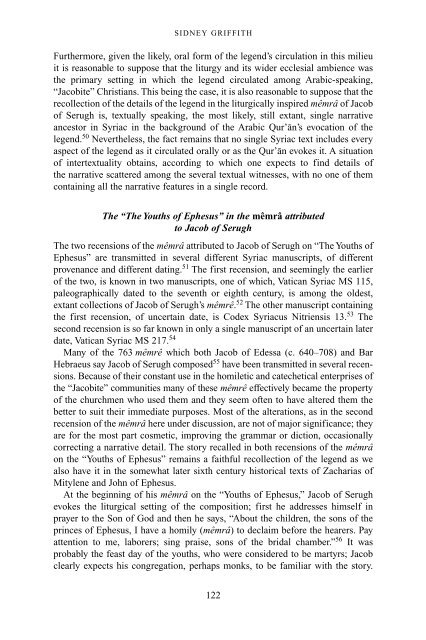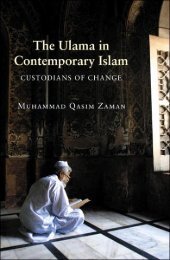The Qur'an in its historical context (pdf - Islam and Christian-Muslim ...
The Qur'an in its historical context (pdf - Islam and Christian-Muslim ...
The Qur'an in its historical context (pdf - Islam and Christian-Muslim ...
Create successful ePaper yourself
Turn your PDF publications into a flip-book with our unique Google optimized e-Paper software.
SIDNEY GRIFFITH<br />
Furthermore, given the likely, oral form of the legend’s circulation <strong>in</strong> this milieu<br />
it is reasonable to suppose that the liturgy <strong>and</strong> <strong>its</strong> wider ecclesial ambience was<br />
the primary sett<strong>in</strong>g <strong>in</strong> which the legend circulated among Arabic-speak<strong>in</strong>g,<br />
“Jacobite” <strong>Christian</strong>s. This be<strong>in</strong>g the case, it is also reasonable to suppose that the<br />
recollection of the details of the legend <strong>in</strong> the liturgically <strong>in</strong>spired mêmrâ of Jacob<br />
of Serugh is, textually speak<strong>in</strong>g, the most likely, still extant, s<strong>in</strong>gle narrative<br />
ancestor <strong>in</strong> Syriac <strong>in</strong> the background of the Arabic Qur’an’s evocation of the<br />
legend. 50 Nevertheless, the fact rema<strong>in</strong>s that no s<strong>in</strong>gle Syriac text <strong>in</strong>cludes every<br />
aspect of the legend as it circulated orally or as the Qur’an evokes it. A situation<br />
of <strong>in</strong>tertextuality obta<strong>in</strong>s, accord<strong>in</strong>g to which one expects to f<strong>in</strong>d details of<br />
the narrative scattered among the several textual witnesses, with no one of them<br />
conta<strong>in</strong><strong>in</strong>g all the narrative features <strong>in</strong> a s<strong>in</strong>gle record.<br />
<strong>The</strong> “<strong>The</strong> Youths of Ephesus” <strong>in</strong> the mêmrâ attributed<br />
to Jacob of Serugh<br />
<strong>The</strong> two recensions of the mêmrâ attributed to Jacob of Serugh on “<strong>The</strong> Youths of<br />
Ephesus” are transmitted <strong>in</strong> several different Syriac manuscripts, of different<br />
provenance <strong>and</strong> different dat<strong>in</strong>g. 51 <strong>The</strong> first recension, <strong>and</strong> seem<strong>in</strong>gly the earlier<br />
of the two, is known <strong>in</strong> two manuscripts, one of which, Vatican Syriac MS 115,<br />
paleographically dated to the seventh or eighth century, is among the oldest,<br />
extant collections of Jacob of Serugh’s mêmrê. 52 <strong>The</strong> other manuscript conta<strong>in</strong><strong>in</strong>g<br />
the first recension, of uncerta<strong>in</strong> date, is Codex Syriacus Nitriensis 13. 53 <strong>The</strong><br />
second recension is so far known <strong>in</strong> only a s<strong>in</strong>gle manuscript of an uncerta<strong>in</strong> later<br />
date, Vatican Syriac MS 217. 54<br />
Many of the 763 mêmrê which both Jacob of Edessa (c. 640–708) <strong>and</strong> Bar<br />
Hebraeus say Jacob of Serugh composed55 have been transmitted <strong>in</strong> several recensions.<br />
Because of their constant use <strong>in</strong> the homiletic <strong>and</strong> catechetical enterprises of<br />
the “Jacobite” communities many of these mêmrê effectively became the property<br />
of the churchmen who used them <strong>and</strong> they seem often to have altered them the<br />
better to suit their immediate purposes. Most of the alterations, as <strong>in</strong> the second<br />
recension of the mêmrâ here under discussion, are not of major significance; they<br />
are for the most part cosmetic, improv<strong>in</strong>g the grammar or diction, occasionally<br />
correct<strong>in</strong>g a narrative detail. <strong>The</strong> story recalled <strong>in</strong> both recensions of the mêmrâ<br />
on the “Youths of Ephesus” rema<strong>in</strong>s a faithful recollection of the legend as we<br />
also have it <strong>in</strong> the somewhat later sixth century <strong>historical</strong> texts of Zacharias of<br />
Mitylene <strong>and</strong> John of Ephesus.<br />
At the beg<strong>in</strong>n<strong>in</strong>g of his mêmrâ on the “Youths of Ephesus,” Jacob of Serugh<br />
evokes the liturgical sett<strong>in</strong>g of the composition; first he addresses himself <strong>in</strong><br />
prayer to the Son of God <strong>and</strong> then he says, “About the children, the sons of the<br />
pr<strong>in</strong>ces of Ephesus, I have a homily (mêmrâ) to declaim before the hearers. Pay<br />
attention to me, laborers; s<strong>in</strong>g praise, sons of the bridal chamber.” 56 It was<br />
probably the feast day of the youths, who were considered to be martyrs; Jacob<br />
clearly expects his congregation, perhaps monks, to be familiar with the story.<br />
122



